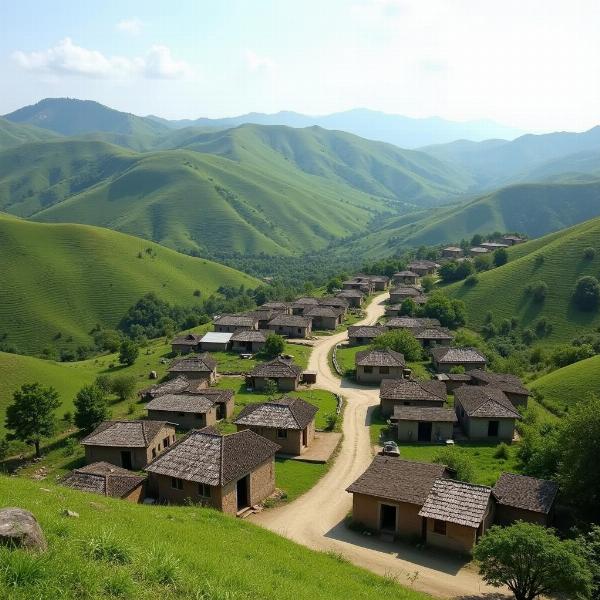Understanding the meaning of “remote areas” in Hindi is crucial for anyone working, travelling, or communicating with people in India. It goes beyond a simple translation and encompasses cultural nuances and practical implications. Knowing how to describe and discuss remote areas in Hindi accurately can bridge communication gaps and facilitate better understanding.
What Does “Remote Areas” Mean in Hindi?
The most common Hindi translations for “remote areas” are दूरदराज इलाके (dūrdarāz ilāqe), सुदूर क्षेत्र (sudūr kṣetra), and दुर्गम क्षेत्र (durgam kṣetra). While all three convey the idea of remoteness, they have slightly different connotations. दूरदराज इलाके (dūrdarāz ilāqe) emphasizes distance, सुदूर क्षेत्र (sudūr kṣetra) highlights the far-off nature of the area, and दुर्गम क्षेत्र (durgam kṣetra) focuses on the difficulty of access.
 Remote Village in India
Remote Village in India
Different Ways to Express Remoteness in Hindi
Beyond the standard translations, Hindi offers various ways to express the concept of remoteness depending on the specific context. For instance, one might use phrases like पहाड़ी इलाका (pahāṛī ilākā) for mountainous regions, जंगली इलाका (janglī ilākā) for forested areas, or पिछड़ा इलाका (pichṛā ilākā) for underdeveloped regions. Choosing the appropriate term depends on the specific characteristics of the remote area being discussed.
Understanding the Nuances of “Remote”
The concept of “remote” can vary based on factors like infrastructure, accessibility, and population density. An area might be geographically distant but well-connected by roads and communication networks, while another might be closer to urban centers but difficult to reach due to challenging terrain. These nuances are crucial when translating and interpreting the meaning of “remote areas” in Hindi.
Importance of Understanding “Remote Areas” in Different Contexts
Knowing the correct terminology for “remote areas” in Hindi is essential in various situations. For instance, when discussing government policies targeting rural development, using the appropriate Hindi terms ensures clear communication and effective implementation. Similarly, in business contexts, understanding the challenges of operating in remote areas is crucial for logistics and market research.
“Remote Areas” in Government and Business
Government schemes often use specific terminology to define “remote areas” for targeted interventions. Understanding these definitions is crucial for accessing benefits and resources. Businesses operating in remote areas must also adapt their strategies to address logistical challenges and cultural differences.
Navigating “Remote Areas”: Practical Implications
When travelling or working in remote areas of India, knowing how to describe your location accurately in Hindi can be invaluable. It can help you seek directions, access local services, and communicate effectively with residents.
Conclusion
Understanding the meaning of “remote areas” in Hindi is more than just knowing the translation. It involves grasping the cultural context, practical implications, and specific terminology used in different situations. This knowledge is essential for effective communication, successful business ventures, and meaningful interactions with local communities in remote areas of India. By embracing the nuances of the language, we can bridge cultural divides and foster deeper understanding.
FAQs
- What is the most accurate Hindi translation for “remote areas”? The most accurate translation depends on the specific context. दूरदराज इलाके (dūrdarāz ilāqe), सुदूर क्षेत्र (sudūr kṣetra), and दुर्गम क्षेत्र (durgam kṣetra) are commonly used.
- How does the concept of “remote” vary in India? Remoteness can vary based on factors like infrastructure, accessibility, population density, and geographical features.
- Why is it important to understand the meaning of “remote areas” in Hindi? Understanding the meaning is crucial for effective communication, business operations, government policy implementation, and travel.
- What are some practical tips for navigating remote areas in India? Learning basic Hindi phrases, researching local customs, and being prepared for limited infrastructure are essential.
- Where can I find more information on remote areas in India? Government websites, travel guides, and academic resources can provide further information.
- How does the language used to describe remote areas impact communication? Using the appropriate Hindi terms ensures clear communication and avoids misunderstandings.
- What are some cultural considerations when visiting remote areas in India? Respecting local customs, traditions, and dress codes is essential.
Meaning-Hindi.in is your trusted partner for professional translation services, specializing in various fields from business and legal documents to technical manuals and website localization. We offer accurate and culturally sensitive translations in Hindi and other languages, ensuring your message resonates effectively with your target audience. Whether you need to translate business contracts, legal documents, technical specifications, educational materials, or website content, our team of expert linguists is dedicated to providing high-quality translations tailored to your specific needs. Contact us today for a customized solution: Email: [email protected], Phone: +91 11-4502-7584. Meaning-Hindi.in helps bridge the communication gap and facilitate seamless cross-cultural understanding.